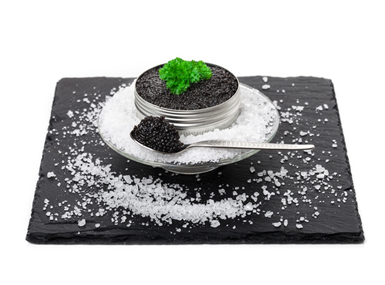


To the south of Shanghai, in the fresh, unpolluted waters of Lake Qindaoh – known as the Lake of a Thousand Isles – the Chinese sturgeon, called Schrenckii, swims and reproduces. These farmed sturgeons have eggs which, say caviar connoisseurs, have a quality that's superior to all the others.
Chinese caviar acclaimed.
Cousin of the Beluga, Schrenckii caviar is a quality caviar which is a perfect reflection of the savoir faire of Chinese aquaculture. Today, 400,000 sturgeons are divided up between three fish farms.
Selected by Iranian and Russian caviar experts, and supported by local labour, Chinese caviar grains are appreciated for their firmness, their subtly sea-scented flavour and their brilliant black colour.
It's hardly surprising, therefore, that some of the greatest chefs in the world such as Alain Ducasse (Plaza Athénée) and Bernard Pécaud (l'Ambroisie) have decided to put them on their menus.
There's no doubt that such a truly exceptional caviar has ended certain out-of-date ideas about counterfeit Chinese products.
A tempting caviar.
Schrenckii caviar arouses our eyes before seducing our palate. Its golden colour and its pretty glints give it such an attractive appearance. When eating it you will love the firmness of its grains and its delicate sea-salty flavours.
A reasonable caviar.
Chinese caviar, as a luxury gastronomic product, never stops developing. Taking advantage of the importation ban on Iranian and Russian caviars, China has multiplied its production and its exports.In addition to its flavour, its price is also very attractive. Russian Beluga or Baeri would cost about €8,000/kilo, while the Chinese variety sells at about €3,000/kilo.
China is today one of the largest caviar producers in the world, unlike in the past. Chinese aquaculture expertise once used to be confined to carp. But, since the Fifties, the Land of the Rising Sun has had an increasingly powerful reputation for their work with sturgeon.
With a wealth of Russian and Iranian experience, renowned as experts, the Chinese today supply exceptional caviars which are appreciated by connoisseurs and gourmets and served in the finest restaurants.Schrenckii caviar.
Chinese caviar (called “Schrenckii”) comes from farmed sturgeons which mature in the freshwater River Amur, on the border between Russia and China.
It's a gold-coloured caviar – a mixture of golden and amber tones. In the mouth, there's an explosion as these small grains burst. There are delicate after-notes of walnut, hazelnut and almond. Its taste is very close to Ossetra caviar.
Eaten, like every other caviar, with a small mother-of-pearl spoon which is delicately pushed sideways inside the small container. The small, elegantly-designed tin is presented on a bed of ice piled high enough to allow it to be kept at the right temperature.